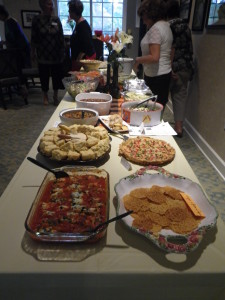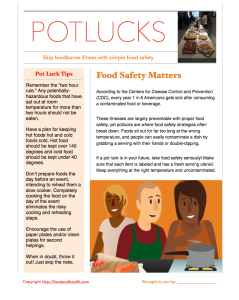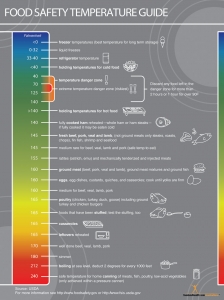Over the years I’ve been invited to speak at many meetings and events. Quite often these occasions include food. Frequently, it’s a potluck affair. I’m usually invited to join them for a meal after the program, but I must confess that I often decline.
Well, let’s start with the type of meal the groups are putting together. Potlucks can go by many names — carry-in dinners, pass-a-dish, potlucks, or covered dishes. No matter what you call them, potlucks are scary. It all comes down to foodborne illness.
According to the CDC, every year 1 in 6 Americans gets sick after consuming a contaminated food or beverage. These illnesses are largely preventable with proper food safety, yet potlucks are where food safety strategies often break down. Foods sit out for far too long at the wrong temperature, and people can easily contaminate a dish by grabbing a serving with their hands or double-dipping. When I can, I avoid potlucks or turn them into “teachable moments.”
So is a pot luck in your future? If it is, here are a few dos and don’ts for a food-safe event:
- Do remember the “two hour rule.” Any potentially-hazardous foods (dairy, meat, fish, cooked vegetables, rice, or chopped/sliced fruits and vegetables) that have sat out at room temperature for more than two hours should not be eaten. If the room temperature is more than 90 degrees, make it a “one hour rule.”
- Do have a plan for keeping hot foods hot and cold foods cold. Hot food should be kept over 140 degrees and cold food should be kept under 40 degrees. If the situation does not allow for temperature control of the food, consider taking (and eating) foods that are less risky. Think bread, chips, nuts, dried fruits, cookies, pretzels, or washed whole fruit.
- Do consider transportation before you decide on what you’re taking. Can you keep it hot or cold while getting it to the event? Count the transportation time in the “two hour rule.”
- Don’t forget to wash your hands. When preparing foods for an event, take extra care at home to keep things clean and safe. Be sure to wash your hands before cooking. Plus, if there are animals in your home, keep them away from the food and preparation area.
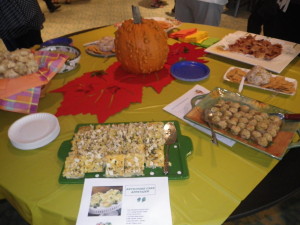 Don’t prepare food for other people if you’re sick. If you’ve had the sniffles, vomiting, or diarrhea in the past few days, then don’t cook!
Don’t prepare food for other people if you’re sick. If you’ve had the sniffles, vomiting, or diarrhea in the past few days, then don’t cook!- Don’t partially cook food at home to finish at the pot luck. The best method would be to completely cook all potentially-hazardous foods at the meal site.
- Don’t prepare foods the day before with the intent of reheating in a slow cooker. Completely cooking the food on the day of the event eliminates the risky cooling and reheating steps.
- Do use enough ice. If you’re using coolers to keep food cold, make sure to have enough ice to keep the foods below 40 degrees.
- Don’t use slow cookers to reheat leftovers. This is too slow. If you’re using a slow cooker to keep the food hot, reheat the food to 165 degrees and then put it in the slow cooker.
- Don’t use warming trays to cook or reheat food. These appliances are not designed for this purpose.
- Don’t wait to eat. If facilities are not available to keep the food at the correct temperature, don’t wait until the speaker is done or the “short” business meeting is over to eat.
- Do encourage people to label and describe their food items. This will help with possible food allergies, and also will keep people from smelling or touching the foods with their hands, taking just a little taste in line to see what it is.
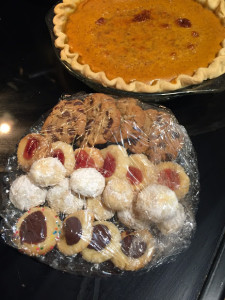 Do remember to have tongs or other serving utensils available. This will help people avoid using their fingers or “double dipping.”
Do remember to have tongs or other serving utensils available. This will help people avoid using their fingers or “double dipping.”- Do encourage the use of paper plates and/or clean plates for “seconds” and desserts.
- Do refrigerate leftovers ASAP. Break large items into smaller portions so that they will cool more quickly. Don’t wait for the speaker to be done or the meeting to be over before cleaning up.
- Do remember plastic wrap or zip-top bags to allow for quick clean-up and refrigerator storage.
- Don’t take leftovers home. This could be risky. Not only has the food sat out at room temperatures for a long time, there is potential contamination from the many people passing through the buffet line.
- Do throw away any leftovers that you are not sure about. All potentially-hazardous leftovers should be discarded.
- Do remember the garbage. Bring extra garbage bags. Prevent potential contamination by keeping the garbage away from the food preparation and serving areas.
Here’s a handout with the top potluck tips. Feel free to share it with your clients!
By Cheryle Jones Syracuse, MS, Professor Emeritus at The Ohio State University
And of course, there are plenty of food safety educational materials available in the Nutrition Education Store. Check out these top sellers!
BUT WAIT, THERE’S MORE! The Nutrition Education Store just got a lot of new products up and running. I’m sure that you will find something that will make your job easier. Here are a few favorites so far…
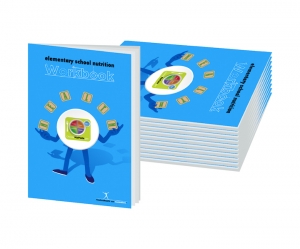
Elementary Nutrition Workbook

Snack Guide Handout Tearpad

MyPlate Brochure Card
New Products Available Now
Check out the Nutrition Nuggets page which features over 20% off three special products each week.
Connect with us on Google Plus















